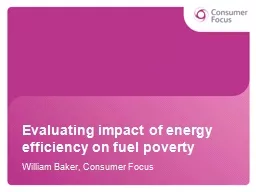

William Baker Consumer Focus Understanding fuel poverty Emergence of energy poverty in EU single liberalised market accession of former Soviet Union states rising energy prices cost of addressing climate change ID: 783699
Download The PPT/PDF document "Evaluating impact of energy efficiency o..." is the property of its rightful owner. Permission is granted to download and print the materials on this web site for personal, non-commercial use only, and to display it on your personal computer provided you do not modify the materials and that you retain all copyright notices contained in the materials. By downloading content from our website, you accept the terms of this agreement.
Slide1
Evaluating impact of energy efficiency on fuel poverty
William Baker, Consumer Focus
Slide2Understanding fuel poverty
Emergence of ‘energy poverty’ in EU
single liberalised market
accession of former Soviet Union states
rising energy prices, cost of addressing climate change
Tackling energy poverty
2009 gas & electricity Directives:
MSs: national action plans to tackle ‘energy poverty
’
Defining energy/fuel poverty
only UK & Ireland have definition
EESC: EU should adopt common definition of energy poverty
Slide3What is fuel poverty?
Drivers
differ across EU: welfare, liberalisation, housing quality, climate
UK:
energy inefficiency, high fuel prices, low income
UK definition:
A household that needs to spend 10% of more of its income on fuel to secure adequate warmth and meet other energy needsadequate warmth: 21o in living room, 18o in other rooms (WHO)Measuring fuel poverty in EuropeEU-SILC?: ‘h/hds unable to keep home warm’, ‘utility bill arrears’, ‘leaks, damp or rot in home’
3
Slide4Energy poverty in Europe
Source: Thomson
(2011
),
Qualifying and quantifying fuel poverty across the
EU
EPEE (2009): 50m – 125m energy poor in Europe
Slide5UK fuel poverty policy
2000 Warm Homes & Conservation Act
e
liminate fuel poverty in England by 2016
similar targets for Scotland, Wales & Northern Ireland
2001 Fuel Poverty Strategy:
tackle 3 causes of FPEmphasis on energy efficiency Warm Front grants for benefit recipients in private housingDecent Homes programme for social housingsupplier obligation for ‘priority group’ consumersAlso income and prices, e.g.Cold Weather Payments, Winter Fuel Payments, Warm Home Discount
Slide6Measuring progress
Annual
English Housing Survey
housing: thermal performance, heating system etc
h
ousehold: income, number of people, tenancy
etcAnnual fuel poverty progress reportkey indicator = number of households in fuel povertybinary indicator: either in or out of fuel povertyIndividual FP programmes, e.g. Warm Frontnumbers helped, SAP improvement measuredimpact on fuel poverty not measured
Slide7UK fuel poverty trends
Source: DECC (2011), Consumer Focus (2012) and
Camco
(2012)
2011 & 2012= projections
Slide8Evaluating impact of schemes: issues
Propensity (‘hit rate’) versus coverage
75% of those eligible for Warm Front are not
FP
(NAO, 2009)
2011 Warm Front changes: stricter eligibility criteria
high propensity: 77% of eligible group are fuel poorBUT poor coverage: 100,000 over 2 years = 2.5% of totaltrade off between propensity and coverageFuel poverty severity11% 9% = success, yet small intervention30% 11% = failure, yet major interventionNo systematic assessment of impact on cold homes, health, fuel under-spend, disposable income
Slide9Evaluation of Warm Zone pilots (2001-5)
Five area-based pilots to tackle fuel poverty
Evaluation tools used
n
o. and % removed from fuel poverty
propensity and coverage
distance travelled: fuel poverty gap = ∑1 to n (current FPI – 9.9%)total=no. of FPI % points to remove all h/hds from FPadditionality: impact over and above BAU (national trend)output/£1000 invested (cost effectiveness)p
rogress at different stages of delivery
Slide10Progress at each stage of WZ delivery
Source: CSE & NEA (2005),
Warm Zones external evaluation
Slide11Hills Interim Fuel
Poverty Review 2011
Critique of fuel poverty definition
fixed 10% threshold: not current, little evidence
ratio: numerator/denominator problem
income not measured according to IN standards
New proposed definition of fuel poverty: A household that faces higher than typical costs; andwere it to spend that amount, would fall below the poverty lineFP = those below ‘low income’ and ‘high required fuel cost’ thresholdsnew ‘fuel poverty gap’ indicator also proposeddefinition can’t be used in other EU countries
Slide12See Figures 7.2 and
7.3in
report
Hill’s ‘low income/high costs’ indicator
We are consultingon how to set the thresholds.Fuel poor:Income < t/hold /high energy costs
Source: Hills (2011),
Fuel poverty and its measurement
Slide13Comparing indicators
Number of households (millions)
Fuel poverty gap (£ billion)
Source: Hills (2011),
Fuel poverty and its measurement
Slide14New approaches to assessing fuel poverty
‘
Fuel poverty proofing’
EE standards sufficiently high to ensure no occupant lives in FP
set SAP/EPC target
for
retrofitting homes toscale of intervention determined by starting point of homeOptimising interventions:optimal combination of EE, income & fuel price interventionsbiggest ‘bang for bucks’ for given level of expenditureOptimising outcomeshealth, quality of life & health expenditurecarbon reductionincreased disposable income due to reduced billseconomic benefits
Slide15Fuel poverty proofing
Consumer Focus: ‘
Raising the SAP
’ (2010)
fuel poor h
omes improved to EPC B (new homes standard)
83% of fuel poor removed from fuel povertyprotection against future price risesCamco: Energy Bill Revolution (2012)recycle ETS auction proceeds into EE programmetarget EPC B standard for 9.1m fuel poor h/hds87% removed from fuel povertyaverage bill saving: £310pa30k-50k direct jobs; 120k-200k indirect jobs (4 x Govt plans)carbon saving 4 x higher than Govt plans
Slide16Consumer Focus
t 020 7799 7900Fleetbank House, f 020 7799 7901
Salisbury Square
contact@consumerfocus.org.uk
London
www.consumerfocus.org.uk
EC4Y 8JX william.baker@consumerfocus.org.uk